Feast Day: July 25th
Actually, St. Christopher is no longer a saint – technically. He was removed from the Catholic Church Calendar in 1969 because they don’t believe he was real.
Anyhoo, St. Christopher is the guy you want in a picture on a pendant around your neck or on your dashboard when you’re on the go since he is the patron saint of travelers because Jesus traveled ON him. Get it? For those of you who are more literal-minded: His name in Greek, Christophoros, means “one who carries Christ.”
Let’s start from the beginning: Christopher was a giant from Canaan who was interested in hanging out with all of the BPs, like kings and Satan, but when they disappointed him, he decided he’d try to get with JC. He met a hermit who helped him to dedicate his life to taxiing poor and weak people across a river on his back and praying a lot. One day, he picked up a tiny little baby passenger and started wading across the river when he was like, “how is this baby AS HEAVY AS A HOUSE?” and he could barely move and the (obviously linguistically gifted) baby replied, “It’s because, Chrissy ol’ boy, you have been carrying the whole world. I am Jesus Christ, the king you seek. SURPRISE!” And just to prove it Jesus told him to plant his walking stick into the ground and naturally the next day it grew into a palm tree and bore fruit.
Like all early Christian saints, he was martyred for his faith and like many of them, he was beheaded. Off with his head!
St. Christopher in Art
Maybe because he was a giant, or perhaps because people thought it was just a good thing in general to catch a glimpse of him, during the middle ages there were huge paintings of him in churches. When his image is huge on the outside of churches, it’s so people can see it from far away. (Duh.)
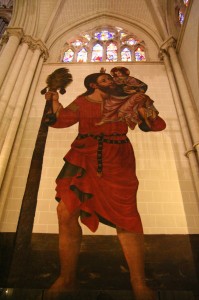
St. Christopher, wall mural in Toledo Cathedral, Spain, 15th century, Photo by Holly Hays via Flickr, Creative Commons Attribution-NonCommercial 2.0 Generic License.
You’ll almost always see him carrying baby Jesus across a river. Usually he has whiskers on his chinny chin chin.
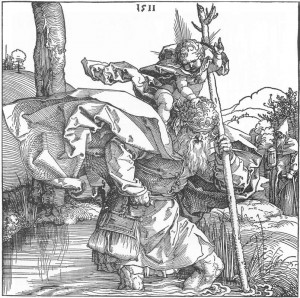
Albrecht Dürer, St. Christopher, 1511, woodcut, 8 5/8” x 8 7/8” British Museum, London, public Domain via Wikimedia Commons.
Sometimes his staff is the palm tree, with or without bunches of dates.
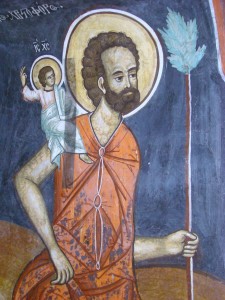
Wall painting of St. Christopher, 1703-1712, Church in the Polovragi Monastery, Romania, Photo by Țetcu Mircea Rareș, Creative Commons Attribution-Share Alike 3.0 Romania license via Wikimedia Commons.
In any saint lineup, he’s the big guy. Which one is St. Christopher in this picture?

Jan van Eyck, detail from the Ghent Altarpiece, 1432, St. Bavo’s Cathedral, Ghent, Public Domain via Wikimedia Commons.
Nothing is more fun than a mistranslation! When you see Christopher with a dog’s head, it means that someone mistranslated Canaanite (cananeus) into canine (canineus).
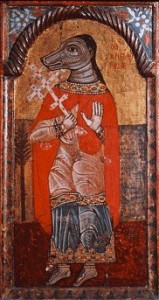
St. Christopher Cynocephalus, 1685, Byzantine Museum, Athens, Photo by ancientartpodcast.org via Flickr, Attribution-NonCommercial-ShareAlike 2.0 Generic License.
There’s that hermit in the background – you know, the helpful one.
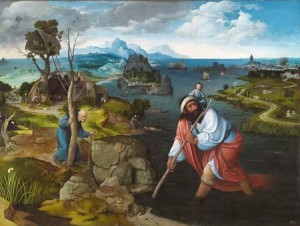
Joachim Patinir, St. Christopher, 1525, oil on panel, Escorial, Real Monasterio de San Lorenzo, Public Domain via Wikimedia Commons.
“Kid, you’re killing my back!”
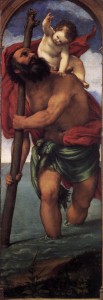
Lorenzo Lotto, St. Christopher, 1531, oil on canvas, 63.8” x 22.4”, Gemäldegalerie der Staatliche Museen zu Berlin, Public Domain via Wikimedia Commons.
If you want to get some stuff with St. Christopher on it, click here.